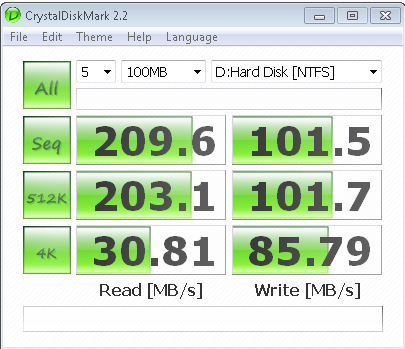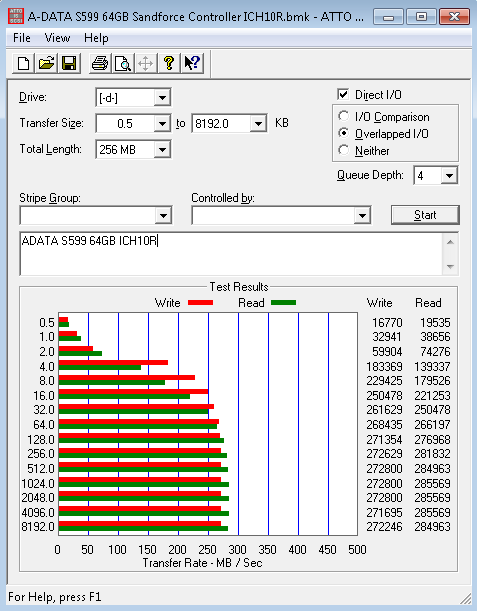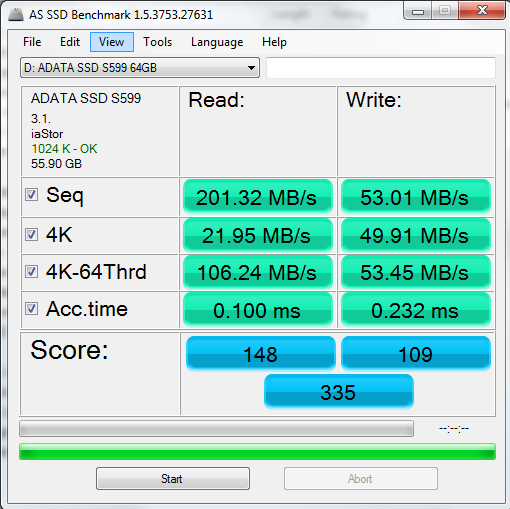One of the most annoying things in SSDs these days is the fact that virtually every manufacturer uses mail-in rebates to make their SSDs appear more affordable. The ADATA S599 64GB is based on the Sandforce SF-1222 controller like many other popular Sandforce consumer drives such as the OCZ Agility 2 and OCZ Vertex 2, Corsair Force, Patriot Inferno, and G.Skill Phoenix Pro. With the internals being largely the same between manufacturers the two main differentiators are warranty and price. Since I needed an additional drive for a ZFS L2ARC SSD for my NexentaCore + napp-it build, I decided to go with another Sandforce based drive. The ADATA’s low price and lack of a mail-in rebate attracted me immediately. The big question I had was whether the ADATA S599 would perform as well as my OCZ Agility 2 which I reviewed earlier.
A few things should be mentioned off the bat. First, the ADATA S599 retail package comes with a blue 2.5″ to 3.5″ converter. For those that need one, this is a great bonus for a SSD that costs just over $100.
Second, the SSD may advertise being 64GB, but after the 1,000 to 1,024 base conversion, and formatting are taken into account, the usable drive size is actually 55.8GB usable. That is not bad, it is just a lot lower than some users may expect.
Test Configuration
For the test configuration I used the same setup as I have been using for my SSD reviews:
- CPU: Intel Core i7 920
- Motherboard: Gigabyte X58-Extreme
- Memory: 12GB of Corsair Dominator GT 1600 C7 DDR3
- Case: CoolerMaster Cosmos S
- Drives (OS): 2x OCZ Vertex 120GB in RAID 0
- SSDs: OCZ Agility 2 120GB and ADATA S599 64GB
- Controller: Intel ICH10R with Intel Rapid Storage Technology (RST) 9.6.0.1014
- NIC (additional): Intel Pro/1000 PT Quad
- Host OS: Microsoft Windows 7 Ultimate 64-bit
I will again note that the numbers I find in my testing may not be indicative of what one may see on an AMD or NVIDIA chipset. In fact, I tried installing the drive on a default ICH10R and Windows 7 x64 Pro installation using all default drivers and saw significantly lower performance. Furthermore, I tried an eSATA port on my laptop an again saw poor performance. If installing any SSD, I would strongly suggest installing the newest Intel RST drivers and making sure the SATA controller is set to AHCI or RAID mode.
ADATA S599 64GB Benchmarks
On to the benchmarks! I am using my revised standard benchmark suite to make it easy to compare to other SSD reviews I have posted.
CrystalDiskMark
I have used CrystalDiskMark (and an older one at that at version 2.2) for quite a while now, and so I am providing these results as a point of reference.

One will note that there is not the same performance anomaly that gave over 500MB/s read speeds in the Agility 2 CDM tests. It looks like the ADATA S599 shows more realistic numbers than the Agility 2 in CDM. One will note that while the Agility 2 had much higher sequential numbers, the 4K tests for the ADATA S599 look solid.
ATTO Benchmark
ATTO has been one of my longstanding favorite benchmarks as it usually gives a different view of drive performance than a lot of the other quick benchmarks available.

This is how manufacturers claim 285MB/s read 275MB/s write speeds to Sandforce based drives. The ATTO benchmark basically uses highly compressible data to stream to the disk. Since Sandforce controllers compress data before writing it to flash, this is basically a best case benchmark. I will note though that every Sandforce drive I have seen in the 120GB and 60GB capacities have managed the advertised read/write speeds. The badness is that those advertised figures are really only applicable in synthetic tests, or more specifically, A synthetic test (ATTO).
AS ASSD Benchmark
The AS ASSD Benchmark was developed specifically to test SSDs. This is a new benchmark to my suite that I started to use in the Intel X25-V 40GB RAID 0 benchmarks and used again with the OCZ Agility 2 benchmarks.

Good 4K and 64 thread performance and fairly good sequential speeds. Looking at the three benchmarks on this page, one can see the Sandforce’s controller and compression algorithm at work. Clearly ATTO is used in promotional materials because of the highly compressible data that it writes. Note, the above sequential AS SSD speeds are well below that of an Indilinx drive. With that being said, the Sandforce drives really show a lot of power on smaller reads/ writes which makes them overall better performers.
Conclusion
The ADATA S599 64GB performs fairly similarly to OCZs Agility 2 120GB. There are some cases where the Agility 2 120GB is faster, but with real world usage, I do not think many people will notice a difference. Again, anyone purchasing a Sandforce drive should know two things. First, they are great, fast drives. Second, they will NOT produce 285/275MB/s reads/ writes in the real world. With all that being said, ADATA has a nice Sandforce drive which can currently be purchased for both a low price and more importantly, without a rebate.




I hate rebates too. May buy this.
Although A-data is pretty well known in Europe and Asia, it’s not as well known here in North America. i wonder how’s their RMA process…
Good question. I have not had to try yet (which is good). On the negative side another WD Green 1.5TB died a few hours ago. Western Digital at least has a good RMA process.